Regular readers may recall my penchant for the Tang Dynasty poet, Li Bai, the patron scribe of Daoists, oenophiles, and Daoist oenophiles. I quote from "The Road to Shu is Hard". The Kingdom of Shu is centred on modern-day Chengdu, Sichuan Province.
Ah! so fearsome, and so high,
The road to Shu is hard, harder than climbing to the sky.
Sir, from this journey to the West, will you return someday?
How can you hope to climb the crags along this fearful way?
The road to Shu is hard, harder than climbing to the sky.
Leaning, I stare into the west and utter a long sigh.
Tr. Vikram Seth
The road to Shu is indeed hard, but climbing to the sky is much more practical than in Li Bai's time due to substantial improvements in air-travel links to the southwest. Today's tea comes from a trip to the Kingdom of Shu, though I have a niggling suspicion that it's not quite from the Tang Dynasty.
Caledonian Springs @ 100C in 20cl shengpu pot; 2 scoops; 1 rinse
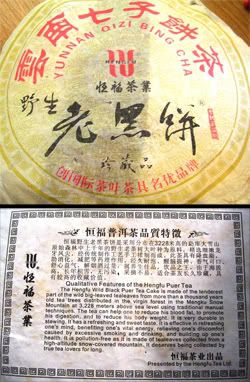 Somewhere in the endless suburbs of Chengdu lies the city's large tea-market, a permanent fixture of tea stores, all frantically buying one another's tea and, on occasion, deigning to sell some to the general public.
Somewhere in the endless suburbs of Chengdu lies the city's large tea-market, a permanent fixture of tea stores, all frantically buying one another's tea and, on occasion, deigning to sell some to the general public.One particular store, the Hengfu outlet run by a quietly-spoken chap by the name of Xiaoxu and his family, resulted in the purchase of this 2004 Hengfu Laohei [old black] bing, among others. His wife provided the snacks, his son... his son sat on his knee, being about four years of age. Xiaomao and I happily overlooked the first day of our commitments, drinking tea with Xiaoxu and his assistant. I mistakenly took his name to be "Xiaozhu" [little pig] with predictable consequences. You just can't take English people anywhere...
Observe the neipiao. Like most Hengfu products, it is, at least, professionally attired and presented. The English is almost correct, too, which is a bit of a treat. Among the usual claims to be a panacea, it indicates that this bing is derived from Daxueshan [big snow-mountain] in Mengku region. They have rather precisely estimated the height of the plantation to be 3228m above sea level, but I suspect that this may actually be 3227m, or even as low as 3226m. Never trust what you read. I like to think of myself as "true tea lovers" and so shall attempt to "collect this tea for long" - but it's tricky, because it turns out to be rather tasty, and we're at least half-way through it already.
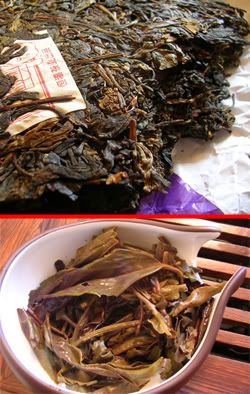 Dry leaves:
Dry leaves:Desirable. Long and thick, with good integrity. Sociably loose compression, being easily pried apart into its constituent leaves without damage. The major impression here is the aroma: it's strong, it's rich, and it's similar in its tobacco style to the celebrity 2001 Menghai Yiwu. When the dry leaves drop into the damp pot, these aromas fill the entire room. The leaves look pretty, do they not?
10s, 15s, 20s, 25s, 35s:
Light orange soup, becoming richly orange in later infusions. Very clean, with a long, enduring scent of fresh corn. The lengxiang is a heavy molasses. "Syrupy."
It has some good age on it already, which is interesting given its youth. The ku of youth is evident, being powerful throughout the mouth, but it isn't raw or unpleasant. It is very rounded and bass, not dissimilar in flavour to the 2001 Menghai with its padding of leathery and tobacco notes. "Very much my cup of tea; like a woman my age, not too old, not too young."
The feeling in the mouth is smooth and oily, with good patience. The huigan is robust and enjoyable.
Used leaves:
Large, whole, and very strong. Some red edges testify to a little oxidation. Rather satisfying to handle.
Overall:
An accomplished young fellow. While accessible, it isn't weak in a "drink it now" sense, exhibiting the potency of character with sufficient support from lower flavours that bodes well for aging. It's a (slight) pity that it won't get the opportunity to age very much before disappearing into our tummies...
Addendum
17 July, 2009
Crikey. The Half-Dipper has changed a great deal over the years! The article above looks alien - though the language is familiar...
It's been over two years since I tried this cake, and it holds a rather special place in our collection. As I wrote about above, we bought this cake a million years ago in Chengdu, and it has been aging with us. I treat this cake as an index of the effectiveness of our storage, it being the cake that we've stored the longest. I can't wait to try it again - fingers crossed!
It's been over two years since I tried this cake, and it holds a rather special place in our collection. As I wrote about above, we bought this cake a million years ago in Chengdu, and it has been aging with us. I treat this cake as an index of the effectiveness of our storage, it being the cake that we've stored the longest. I can't wait to try it again - fingers crossed!
Things are darker. What was previously the dark-green colour of youth is now somewhat rusty (pictured below). I didn't previously note the large proportion of huangpian [yellow flakes] in the blend. It is mostly made of large fragments of good leaves, and it has a dark, woody aroma. I find this extremely encouraging! It's definitely moving in the right direction.
I think back at the price I paid for this and chuckle. I was totally gouged by the seller back then. Expensive tuition!
The soup is dark, having become a lower, chunkier orange than I remember. The biggest change in this cake is that it has developed strong overtones of wood. The body has become slightly sweeter, but plenty of challenge remains in the throat.
It is neither young nor old, and I can see why Marshaln considers them difficult to drink, being neither fresh and zesty, nor aged and reverend. I must confess to enjoying them, however: it has the challenge of youth, which I adore, and comes with strong tones of wood, hinting at its future. My tastes have always been fairly contrary!
Lei makes approving sounds as she grabs a cup in passing.
To find that our storage conditions haven't had a negative effect on the tea is immensely relieving. That it is aging noticeably is a great pleasure - here's hoping for further improvements...
To find that our storage conditions haven't had a negative effect on the tea is immensely relieving. That it is aging noticeably is a great pleasure - here's hoping for further improvements...

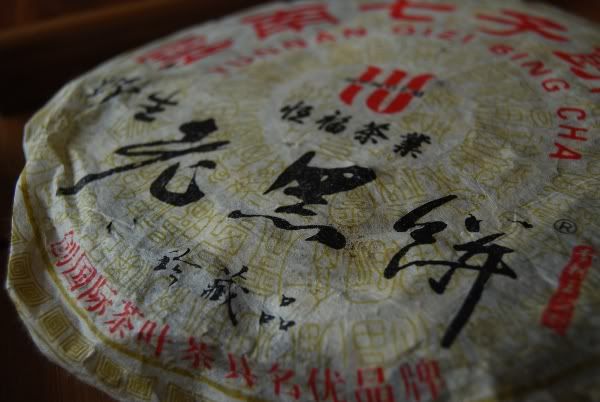
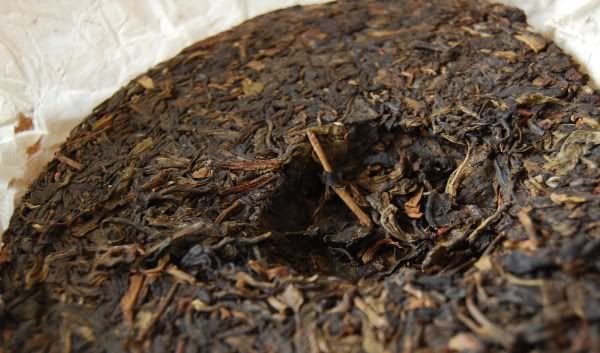

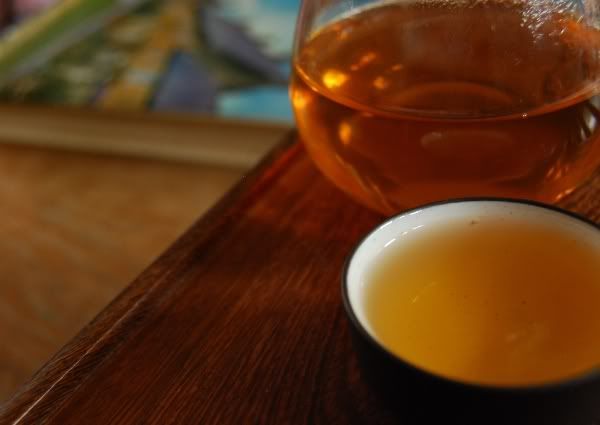
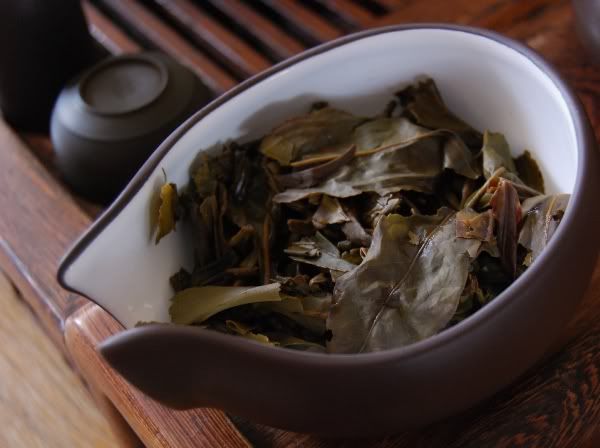
Found the remainder of what you sent today, and must say, I am enjoying the slippery mouthfeel and rounded flavors of this tea in advance of the N. American gorge-fest that is Thanksgiving. Puer is a good foil to all that rich food!
ReplyDeleteHi, Carla!
ReplyDeleteI'm very glad that you enjoyed it. I haven't tried it for absolutely ages, and so you've fully motivated me to get back into the swing of it!
I hope life is treating you well - I've got some tea here I've been meaning to send to you for months. Do forgive me!
Toodlepip,
Hobbes :)
Hobbes! Good to hear from you. My tea drinking continues, but my logging of the experience as well as the purchase of new tea has slackened...life has been pretty busy. Best to you and Lei.
ReplyDelete-Carla
Its so nice to read your posts. Sadly I only bought my first Puerh at the beginning of the year, but it good to hear of others setting things aside of aging. Well hears to hoping both of us much patience and good storage conditions for our tea.
ReplyDeleteDear Adam,
ReplyDeleteThere's nothing sad about that! Welcome aboard. :)
Toodlepip,
Hobbes
Hello Hobbes,
ReplyDeleteCan you describe a bit more the storage method you have been using for this bing? Or is it simply stacked on the "China Post Simulator" with the rest of your tea holdings :)?
Have a good one,
Alex
Dear Alex,
ReplyDeleteYou guessed it! I like my tea storage simple. :)
At the moment, though, they're all tucked away in large boxes in our lounge while we redecorate. The China Post Simulator will live again, however!
Toodlepip,
Hobbes